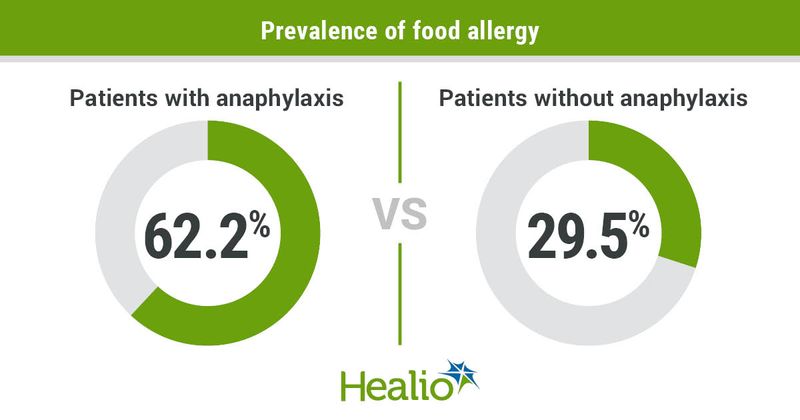Allergic multimorbidity associated with anaphylaxis in adults
Key takeaways:
- Patients who self-reported anaphylaxis in adulthood had significantly higher proportions of asthma, food allergy, allergic conjunctivitis and atopic dermatitis than patients who did not have anaphylaxis.
- Forty-four patients with anaphylaxis had visited an ED in the previous 12 months for allergies or asthma.
- Researchers found a dose-response relationship between the number of allergic diseases and anaphylaxis.
Self-reported anaphylaxis in adults appeared positively associated with the number of allergic diseases they had, according to a study published in Clinical and Translational Allergy.
Clinicians may be able to apply these findings in estimating the risk for anaphylaxis among individual patients, Tuuli Thomander, MD, a doctoral researcher in the doctoral program in clinical research at the University of Helsinki in Finland, and colleagues wrote in the study.

To better understand the relationship between allergic multimorbidity and anaphylaxis in adults, the researchers evaluated data from the Finnish Allergy Barometer Study, which surveyed patients aged 5 to 75 years who purchased allergy or asthma prescriptions at participating pharmacies in September 2010 or September 2016. Out of 1,319 qualifying adult respondents, 164 reported anaphylaxis.
The survey asked participants about their smoking history and if they had ever been diagnosed with asthma, allergic rhinitis (AR), allergic conjunctivitis (AC), atopic dermatitis (AD), food allergy or anaphylaxis.
A significantly greater proportion of patients with vs. without anaphylaxis reported having asthma (86% vs. 67.8%), food allergy (62.2% vs. 29.5%), AC (43.3% vs. 29.4%) and AD (53.7% vs. 34.4%; P < .001 for all), with comparable proportions having AR (82.3% vs. 86.2%).
The anaphylaxis group also was older (mean age, 54.4 years; range, 22-75 vs. 48.6 range, 18-75; P < .001), and a greater percentage had a history of smoking (46.3% vs. 38.2%; P < .05), but there were no gender differences between the groups.
Forty-four individuals in the anaphylaxis group reported that they had visited an ED because of allergies (n = 20) or asthma (n = 24) in the previous 12 months.
The researchers also found a dose-response relationship between anaphylaxis and the number of allergic diseases. Adjusted odds ratios included 1.8 (95% CI, 0.79-4.12) for two diseases, 3.35 (95% CI, 1.47-7.66) for three, 7.5 (95% CI, 3.25-17.32) for four and 13.5 (95% CI, 5.12-33.09) for five, compared with one allergic disease.
When the researchers removed food allergy from the dose-response analysis, adjusted odds ratios included 1.17 (95% CI, 0.68-2.02) for two allergic diseases, 2.13 (95% CI, 1.2-3.7) for three and 5.42 (95% CI, 2.95-9.95) for four.
The adjusted models additionally showed statistically significant associations between older age and higher risks for anaphylaxis with the presence of asthma (OR = 2.91; 95% CI, 1.84-4.6), food allergy (OR = 3.93; 95% CI, 2.8-5.52) and AD (OR = 2.21; 95% CI, 1.59-3.08).
The researchers did not find any statistically significant association between sex, smoking status or the presence of AR or AC with anaphylaxis.
Combinations of allergic diseases, however, had varying positive associations with anaphylaxis compared with groups that did not exhibit these combinations, including:
- Asthma + AR + AC + AD: OR = 2.24 (95% CI, 1.11-4.48)
- Asthma + food allergy: OR = 2.11 (95% CI, 1.06-4.22)
- Asthma + AR + food allergy: OR = 1.87 (95% CI, 1.06-3.33)
- Asthma + AR + AC + food allergy: OR = 2.44; 95% CI, 1.17-5.08
- Asthma + AR + AD + food allergy: OR = 3.35 (95% CI, 1.88-5.99)
Also, AR (OR = 0.18; 95% CI, 0.07-0.5) and asthma plus AR (OR = 0.37; 95% CI, 0.23-0.61) had negative associations with anaphylaxis.
Researchers also identified multimorbid-polysensitized phenotypes that carried higher risk for anaphylaxis. Specifically, compared with AR, AC, asthma or their combinations, food allergy plus asthma or their variations with AR, AC or AD had the highest risk for anaphylaxis (OR = 6.47; 95% CI, 4.33-9.92), followed by food allergy or its variations with AR, AC or AD (OR = 2.65; 95% CI, 1.28-5.5) and AD or its variations with AR, AC or asthma (OR = 2.22; 95% CI, 1.31-3.76).
The researchers concluded that anaphylaxis had a positive association with the number of allergic diseases as well as with subgroups of allergic diseases consisting of food allergy and/or asthma.
Noting these strong associations between allergic multimorbidity and self-reported anaphylaxis in adulthood, the researchers further said that clinicians could apply these findings when estimating the risks for anaphylaxis among their individual patients to better counsel them, although further longitudinal studies are needed.
